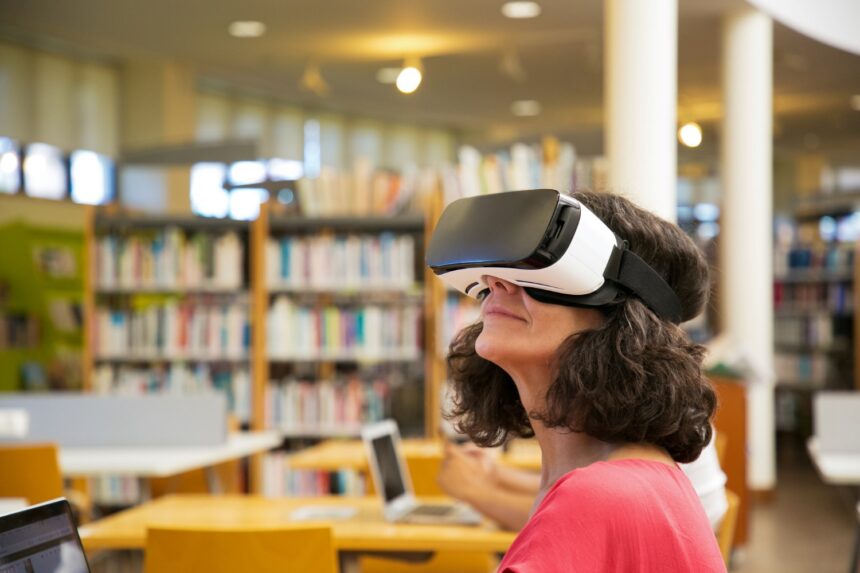I. Introduction
In the rapidly evolving landscape of education, technology continues to play a transformative role, reshaping how students learn and educators teach. With the proliferation of smartphones, tablets, and other digital devices, educational apps have emerged as powerful tools that offer interactive, engaging, and personalized learning experiences. These apps are not just supplementing traditional educational methods but are increasingly becoming integral to the learning process itself.
The future of learning is being shaped by a convergence of trends and innovations in educational apps. From personalized learning paths tailored to individual student needs to immersive experiences using virtual and augmented reality, the possibilities are vast and varied. These technological advancements are fostering an environment where learning is more accessible, inclusive, and effective.
As we navigate through these topics, it becomes evident that the future of learning is not just about incorporating new technologies but about creating a holistic and inclusive educational experience that empowers every learner. Join us as we explore the trends and innovations that are paving the way for the next generation of education.
II. Emerging Trends in Educational Apps
The landscape of education is undergoing a profound transformation, largely driven by the integration of technology in learning environments. Educational apps are at the forefront of this revolution, offering innovative solutions that cater to the diverse needs of students and educators alike.
In this section, we will explore the emerging trends in educational apps that are shaping the future of learning.
A. Personalized Learning
1. Adaptive Learning Algorithms
One of the most significant advancements in educational apps is the implementation of adaptive learning algorithms. These intelligent systems analyze a student’s performance in real-time and adjust the content and difficulty level accordingly. By personalizing the learning experience, adaptive algorithms ensure that each student receives instruction tailored to their unique strengths and weaknesses. This not only enhances understanding and retention but also keeps students engaged by providing a continuous challenge that is neither too easy nor too difficult.
2. Customizable Learning Paths
When learning English online for example, students have the opportunity to tailor their educational path. By utilizing educational platforms that provide customizable learning paths, learners can choose the subjects, topics, and study sequence that align with their individual needs. This personalized approach allows students to concentrate on areas of interest or areas requiring improvement, leading to a more engaging and self-directed learning experience.
3. Student-Centered Approaches
Student-centered approaches in educational apps prioritize the needs and preferences of the learner. These apps often include features such as goal setting, progress tracking, and feedback mechanisms that help students stay motivated and on track. By placing the student at the center of the learning process, these apps promote autonomy and encourage a deeper engagement with the material.
B. Gamification
1. Interactive Game Mechanics
Gamification has emerged as a powerful tool in educational apps, leveraging interactive game mechanics to make learning more engaging and enjoyable. Features such as quizzes, puzzles, and interactive simulations transform traditional learning activities into dynamic and immersive experiences. These game mechanics not only make learning fun but also help reinforce concepts through repetition and active participation.
2. Reward Systems
Reward systems are integral to the gamification of education. Educational apps often incorporate badges, points, leaderboards, and other incentives to reward students for their achievements. These rewards provide immediate feedback and recognition, which can significantly boost motivation and encourage continued effort. By making learning a game, reward systems help sustain interest and drive students to reach their educational goals.
3. Engagement and Motivation
The combination of interactive game mechanics and reward systems leads to higher levels of engagement and motivation. Educational apps that successfully gamify learning create an environment where students are eager to participate and challenge themselves. This heightened engagement can lead to better learning outcomes and a more positive attitude toward education.
C. Virtual and Augmented Reality
1. Immersive Learning Experiences
Virtual and augmented reality (VR and AR) are revolutionizing educational apps by providing immersive learning experiences that were previously unimaginable. VR can transport students to different places and times, allowing them to explore historical events, scientific phenomena, and more in a highly interactive and engaging way. AR, on the other hand, overlays digital information onto the real world, enhancing the learning experience with additional context and interactivity.
2. Simulated Environments
Simulated environments created through VR and AR offer students a safe space to experiment and learn. Whether it’s conducting virtual lab experiments, exploring outer space, or practicing language skills in simulated conversations, these environments provide hands-on learning experiences that can be tailored to individual needs. This kind of experiential learning helps students understand complex concepts more deeply and retain information longer.
3. Enhanced Interactivity
The enhanced interactivity offered by VR and AR technologies allows students to engage with content in new and meaningful ways. Educational apps utilizing these technologies often include features such as interactive 3D models, real-time feedback, and collaborative activities. This level of interactivity not only makes learning more engaging but also supports a variety of learning styles, ensuring that all students can benefit from the technology.
III. Innovations Shaping the Future
The landscape of educational apps is continually evolving, driven by groundbreaking innovations that promise to revolutionize the way we learn. Key technological advancements are not only enhancing the educational experience but also making it more accessible, engaging, and effective.
Here are some of the most significant innovations shaping the future of learning.
A. Artificial Intelligence
Artificial Intelligence (AI) is at the forefront of educational technology, offering a range of capabilities that are transforming learning environments.
1. AI Tutors
AI tutors provide personalized assistance to students, offering help and guidance tailored to individual needs. These virtual tutors can assess a student’s strengths and weaknesses through continuous interaction and adapt their teaching methods accordingly. This ensures that learners receive the support they need to master subjects at their own pace.
2. Content Recommendation Systems
Leveraging AI, content recommendation systems analyze a student’s learning history and preferences to suggest relevant resources and activities. This targeted approach helps keep students engaged by presenting them with materials that are most likely to interest them and meet their educational needs.
3. Predictive Analytics
Predictive analytics harness the power of AI to forecast academic outcomes and identify students who may be at risk of falling behind. By analyzing patterns in student data, educators can intervene early, providing additional support and resources to those who need it most, thereby improving overall academic performance.
B. Blockchain Technology
Blockchain technology, known for its role in securing cryptocurrencies, is making significant inroads into the educational sector, offering novel solutions for credentialing and data management.
1. Secure Credentialing
Blockchain offers a tamper-proof method for issuing and verifying educational credentials, such as diplomas and certificates. This ensures that academic records are secure, verifiable, and easily accessible to both students and employers, reducing the risk of fraud.
2. Decentralized Learning Records
With blockchain, learning records can be decentralized, allowing students to maintain a lifelong, portable educational history. This empowers learners to control their own data and share it with institutions or employers as needed, fostering greater transparency and mobility in the education and job markets.
3. Transparency and Trust
Blockchain’s inherent transparency builds trust among stakeholders by providing a clear and immutable record of educational transactions and achievements. This can enhance the credibility of educational institutions and the qualifications they issue, ultimately benefiting students and educators alike.
C. Internet of Things (IoT)
The Internet of Things (IoT) is connecting devices and creating smart learning environments that offer new ways to engage and educate students.
1. Smart Classrooms
IoT-enabled smart classrooms utilize connected devices and sensors to create a responsive and interactive learning environment. These technologies can monitor classroom conditions, automate administrative tasks, and provide real-time feedback to educators, enhancing the overall teaching and learning experience.
2. Connected Learning Devices
From smartboards to wearable devices, IoT is bringing a new level of interactivity to educational tools. Connected devices can facilitate collaborative learning, track student progress, and provide immersive experiences that make lessons more engaging and effective.
3. Data-Driven Insights
IoT generates vast amounts of data that can be analyzed to gain insights into student behavior, learning patterns, and classroom dynamics. Educators can use this information to tailor their teaching strategies, optimize resource allocation, and improve educational outcomes.
These innovations are not just futuristic concepts but are increasingly being integrated into educational systems worldwide. As these technologies continue to develop, they hold the promise of making education more personalized, secure, and interconnected than ever before, paving the way for a brighter future in learning.
IV. Challenges and Considerations
As educational apps continue to evolve, they bring with them a host of challenges and considerations that developers, educators, and policymakers must address to ensure their effective and ethical use.
Here, we delve into some of the most pressing issues, including privacy and security, accessibility, and the need for comprehensive training for both teachers and students.
A. Privacy and Security
1. Data Protection Laws
With the vast amounts of data being collected by educational apps, ensuring compliance with data protection laws such as the General Data Protection Regulation (GDPR) in Europe and the Children’s Online Privacy Protection Act (COPPA) in the United States is crucial. These laws are designed to protect users’ personal information, especially that of minors, and non-compliance can result in severe penalties. Developers must integrate robust data protection measures from the ground up to align with these regulations.
2. User Consent
Obtaining informed consent from users, particularly when dealing with minors, is a critical aspect of ethical app development. This involves clearly communicating what data will be collected, how it will be used, and who will have access to it. Transparent privacy policies and consent forms are essential to building trust with users and ensuring that they are fully aware of their rights.
3. Secure Platforms
The rise in cyber threats necessitates that educational apps employ advanced security measures to protect sensitive information. This includes encrypting data both in transit and at rest, using secure authentication methods, and regularly updating the software to patch vulnerabilities. Secure platforms not only protect user data but also bolster the credibility of educational apps in the eyes of educators and parents.
B. Accessibility
1. Inclusive Design
To be truly effective, educational apps must be designed with inclusivity in mind. This means accommodating a wide range of abilities and learning styles, including those of students with disabilities. Features such as text-to-speech, adjustable font sizes, and high-contrast modes can make apps more accessible. Inclusive design ensures that all students, regardless of their physical or cognitive abilities, can benefit from digital learning tools.
2. Affordability
While technology has the potential to democratize education, affordability remains a significant barrier. High costs can prevent underprivileged students from accessing educational apps and devices. Developers and policymakers must work together to create affordable solutions and consider subsidized models or partnerships with educational institutions to make these tools accessible to all.
3. Connectivity Issues
In many parts of the world, stable internet access is still a luxury. Educational apps that rely heavily on online connectivity can exclude students in remote or underserved areas. Developing offline capabilities and lightweight versions of apps can help mitigate this issue, ensuring that all students have the opportunity to engage with digital learning, regardless of their internet situation.
C. Teacher and Student Training
1. Professional Development
The successful integration of educational apps into the classroom hinges on the ability of teachers to effectively use these tools. Professional development programs are essential to equip educators with the skills and knowledge needed to navigate and leverage educational technology. Ongoing training ensures that teachers remain up-to-date with the latest advancements and best practices.
2. Student Onboarding
Introducing new technology to students requires a well-thought-out onboarding process. This includes providing tutorials, user guides, and initial support to help students become familiar with the app’s interface and functionalities. Effective onboarding can enhance student engagement and reduce the learning curve associated with new technology.
3. Ongoing Support
Both teachers and students require continuous support to address any technical issues or challenges that arise. This may involve dedicated help desks, customer support teams, and regular updates to address user feedback and improve the app’s performance. Ongoing support ensures that educational apps remain user-friendly and effective over time.
V. Conclusion
As we navigate the ever-evolving landscape of education, it becomes increasingly clear that educational apps are not just a fleeting trend but a cornerstone of modern learning. Through the integration of personalized learning, gamification, and immersive technologies like virtual and augmented reality, these apps are transforming how students engage with and absorb information. The innovations driven by artificial intelligence, blockchain technology, and the Internet of Things are pushing the boundaries even further, promising a future where learning is more efficient, secure, and tailored to individual needs.
In conclusion, the future of learning through educational apps is bright and full of potential. By embracing these emerging trends and innovations, while conscientiously addressing the associated challenges, we can create an educational ecosystem that is not only more engaging and effective but also equitable and secure for all. As stakeholders in this transformative journey—educators, developers, policymakers, and students alike—we must collaborate to realize this vision, ensuring that the future of learning is inclusive, dynamic, and empowering.






